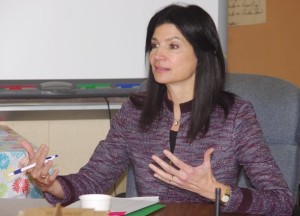Bien Hecho: Lily Eskelsen – From Lunch Lady to National Education Leader
 By Griselda Nevarez, Voxxi
By Griselda Nevarez, Voxxi
She is currently the vice president of the National Education Association and is gearing up to compete for the NEA’s president seat. She will announce her candidacy for president at the group’s annual convention, which will be held in Atlanta, Georgia, from June 26–July 6.
 If she is elected president by the NEA’s 3.2 million members, she will become the organization’s first Hispanic president. That position would also give her an even more powerful voice to advocate for Latino students.
If she is elected president by the NEA’s 3.2 million members, she will become the organization’s first Hispanic president. That position would also give her an even more powerful voice to advocate for Latino students.
Lily Eskelsen’s story of how she got to the NEA is filled with stories of people, especially of former students, who made an impact in her life. She recently shared her story with VOXXI.
She began by speaking about her upbringing. Her maternal grandfather is from Nicaragua, her mother is from Panama and her father served in the U.S. Army. Growing up in a military family, Eskelsen and her five siblings moved every two to three years until her father retired and they moved to Utah.
“When people ask me, ‘Where did you grow up?’ I say alphabetically or chronologically?” she said laughing.
Eskelsen’s career as an educator began when she worked as a “lunch lady” for a school cafeteria. She took that job right after graduating from high school and getting married to Ruel, who passed away in 2011 and with whom she had two sons.
Eskelsen worked in the school cafeteria for a few months before becoming an aide for a kindergarten teacher at the school. She recalled playing her guitar and singing songs with the students. A year later, when she was about to turn 20 years old, she was encouraged by the kindergarten teacher to go to college and become a teacher herself.
“That was the first time in my life an adult told me I should go to college,” she told VOXXI.
Eskelsen’s parents never went to college. In fact, her mother finished high school, but her father never completed high school. For her parents, college wasn’t something they thought of for their children.
“It wasn’t that they were against it,” Eskelsen explained. “It just wasn’t part of their history, it wasn’t part of their family.”
Lily Eskelsen on Latino education
Lily Eskelsen makes it through college
Motivated by the kindergarten teacher to go to college, Lily Eskelsen made the decision to enroll at the University of Utah. Her husband, an Army veteran, also joined her and used his G.I. Bill benefits to help pay for part of his tuition. The couple also used loans and Pell grants to cover the tuition cost. And on the weekends, they raised more money by singing in Salt Lake City bars.
Eskelsen and her husband already had their first child, Jeremy, by the time they began attending the University of Utah. She recalled pushing her son in a stroller around the university campus until her husband was out of class. She would then hand him the stroller and rush to her class. They did that for four years until they both graduated.
While most would see juggling college and being a mother as a tough task, Eskelsen describes the experience as being “probably the happiest time of my life.”
Upon graduating magna cum laude and earning a bachelor’s degree in elementary education from the University of Utah, she went back to school to earn a master’s degree in instructional technology. After that, she worked for nine years as a teacher at Orchard Elementary School in Salt Lake City before being named the Utah Teacher of the Year in 1989. A year later, she was elected president of the Utah Education Association.
Why Lily Eskelsen wasn’t taught Spanish growing up
Lily Eskelsen spent most of her teaching career working at a one-room shelter school in the middle-class suburbs of Salt Lake City. She worked there for 20 years.
Seeing that some of the students at that school were Hispanic and spoke Spanish, Eskelsen asked her mother, who emigrated to the United States from Panama in the 1950s when she got married, why she was never taught Spanish.
With tears in her eyes, her mother said there weren’t many people who spoke Spanish when she first arrived in the U.S. She said people stared at her and looked angry whenever she spoke the language in public places.
“I will not have my children speak Spanish, because I don’t want people to be angry at my children,” Eskelsen recalled her mother telling her.
That day, her mother told her she regretted not teaching her Spanish and encouraged her to learn the language. Eskelsen heeded her mother’s advice.
8-year-old boy makes impact in Lily Eskelsen’s life
One of the ways Lily Eskelsen learned Spanish is through an 8-year-old boy named Julio, whom she met while teaching at the shelter school. She described Julio as being poor and as someone who was “very angry” at his situation. His anger led him to have bad behavior in class and to be aggressive toward the other children at the shelter.
During the same time that Eskelsen met Julio, she was taking night classes to learn Spanish at a local high school. She was working on her Spanish homework one day, while she was on recess duty, when she asked Julio to help her with her homework. He agreed and spent months helping her learn Spanish after that.
Slowly, Julio began opening up and helping Eskelsen in class with the younger students.
“All of a sudden he was the teacher … and one day I said to him, ‘You should go to college and be a teacher,’” she said. “I said it just the way the kindergarten teacher had said it to me.”
Eskelsen said Julio laughed and replied, “I ain’t gonna be no teacher. When I go to college, I’m going to be a luchador. I’m going to be a wrestler with the World Wrestling Federation.”
“I laughed and then I got tears in my eyes, because I realized he said, ‘When I go to college,’” Eskelsen said pointing out that this is the mindset all students should have regardless of their background.
Julio is now in his early 20s. Eskelsen didn’t keep in contact with him and doesn’t know if he made it to college.
“All I know is that I planted this little seed in his head and got him to say, ‘When I go to college,’” she said.
Lily Eskelsen on Global Campaign for Education
Latino students need role models
Lily Eskelsen often tells the story of Julio to highlight how the lack of encouragement to go to college coupled with not having enough role models are some of the most pressing issues Latino students are facing.
“We need to highlight those role models, because there’s nothing more powerful to a child than to see someone who looks like them, sounds like them, has a last name like them … and is successful,” she told VOXXI.
Seeing successful Hispanic role models, she added, would also help Latino students get excited about the possibilities instead of the probabilities, which she said “are not on our side.”
Compared to average students, Latino students have lower probabilities of finishing high school, going on to college, graduating from college and making as much money. Eskelsen said part of the reason why this is occurring is because the existing public school system is not designed to help Latino students succeed.
In 2010, President Barack Obama appointed Lily Eskelsen to the White House Initiative on Educational Excellence for Hispanics, a national commission whose goal is to address this and other issues that make it difficult for Latino students to succeed.
The 30-member commission is working on creating better programs for English-language learners, finding ways to train teachers in cultural competency and making college more affordable. Another critical issue the group is tackling is doing away with standardize tests that students must take to get into college. Lily Eskelsen argues that such tests have “a cultural bias” and tell little about a student’s capabilities of making it through college.
She added that the White House Initiative on Educational Excellence for Hispanics is one of the ways the Obama administration has been working to close the Latino education gap. She applauded Obama for it and for his announcement of the deferred action program for undocumented youth.
“To me, this is something that will always be on his report card,” she said of the federal program.
Eskelsen said although she enjoys teaching inside the classroom, working as an education advocate with the NEA has been equally rewarding. That’s because she said the organization provides her the opportunity to advocate for improvements in the pubic education system so that students, like Julio, can succeed.
This article was first published in Voxxi.
Griselda Nevárez is a reporter with Hispanic Link News Service in Washington D.C.
[Photo by NEA Today]



